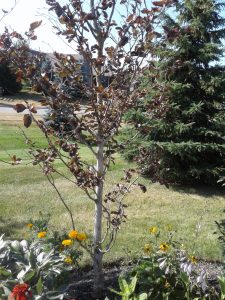
After transplanting the tree two years ago about twenty feet, it has done poorly. The leaves hardly turned tricolor before turning copper. The soil here on the York ridges moraine is sandy. When transplanting it, we filled the hole with triple mix and bone meal. We watered it thoroughly. It is in full sun from mid morning. Any suggestions?
Thank you for contacting the Toronto Master Gardeners concerning your struggling tri-color beech tree.
Tri color beech, Fagus sylvatica ‘Roseo-Marginata’ is a striking tree that one doesn’t soon forget. It is often used as a specimen tree due to its variegated leaves that may come in many shades of green, pink, and white. If this show wasn’t enough they also put on a brilliant show of copper coloured leaves in the fall.
This tree should be planted in part shade in well-drained, moist, slightly acidic soil. The tree may be planted in full sun, however the colour will fade in the hot summer sun and if not shaded the foliage will sometimes burn and edges will become crispy. This summers hot temperatures, little rain and the full sun location is one of the reasons that the leaves on your tree are turning brown.
Root stress could be another reason that the top of your tree is not doing well. A tree tries to find a balance between the top and below ground system. Soil compaction, girdling roots can all lead to root stress. Girdling roots occur when the roots coil around the base and constrict the flow of sap. This can happen when trees are grown in containers, and the problem is exacerbated when they are brought home from the nursery and planted too deep. Your photograph does not show the bottom of the tree, so I cannot tell if its planted too deeply. The following information is from our Gardening Guide, Planting a Tree ,
The importance of planting a tree at the correct depth cannot be overemphasized. Planting too deeply will eventually lead to the death of the tree. The place where the roots meet the trunk is called the trunk flare or the root collar. Unlike roots, trunks are not meant to be buried in soil. If covered in soil the trunk may rot, become diseased or even die. The tree must be placed in the ground so that the soil grade is level with the bottom of the root collar. When planted at the proper level you will see the gentle flare of the trunk rise just above the soil line. Err on the side of placing the tree higher above the soil, especially if you suspect the soil will settle and the tree will sink. It is easier to add soil after planting, than to replant a tree with a sunken trunk flare.
You also mention that you added triple mix to the planting hole. Ideally you should not add new bags of soil or soil amendments to the planting hole when planting a tree. From our Gardening Guide; , It may seem nurturing to add new top soil, manure, compost or peat moss to enhance the soil, but in fact, you are creating a soil pocket which is unlike the surrounding soil. The roots may initially grow well, but, as they come to the edge of the soil in the planting pocket, they will resist growing beyond into the surrounding soil. The tree will be stronger and grow faster if its roots are able to adapt quickly to the given soil conditions and begin to grow out and down into the earth beyond the prepared hole. If you would like to improve the soil, do so gradually by using organic amendments, such as a layer of disease free leaves, in the form of a mulch. Spread mulch around the surface of the soil after the tree is planted, so it will slowly and naturally decompose and work its way into the soil.
Yearly application of organic compost along with a layer of mulch, making sure to keep the mulch a couple of inches away from the trunk will go a long way to improving the health of your tree. A yearly application of fertilizer before the appearance of new growth in spring, typically around March will also improve the health of your tree.
Good Luck with your beech tree.

